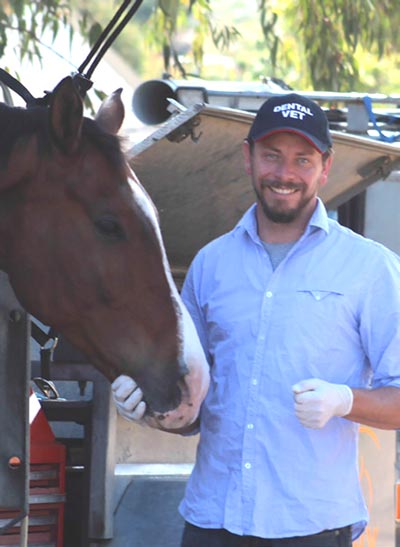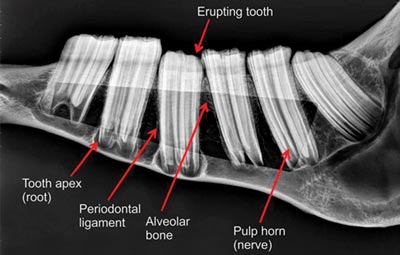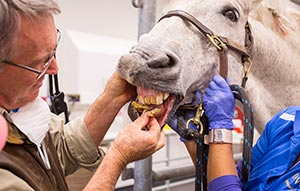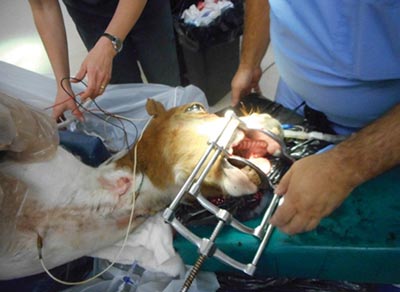
by Dr Shannon Lee BVSc, MANZCVSc Eq Dent, DICEVO
As dental surgery becomes more complicated, so too do the headaches.
For many horse owners, dentistry and dental complaints aren’t something that’s front of mind. After all, their horse looks fine, eats okay and can be ridden.
Furthermore, the assumption is often that, if there was a problem, it would be new, easily identified and quickly fixed, so things could go back to the way they had always been… Right? Wrong!
Fundamentally, this attitude simply derives from a lack of understanding. More often than not, it is also one of the reasons why if a serious issue is discovered in your horse’s mouth necessitating surgery, it may be far more challenging than you might expect. Therefore, delaying diagnosis and early treatment may be both costly and reduce the likelihood of an ideal outcome.
In plain English, this means getting the right advice as early as possible gives you and your horse the best chance of getting things back on track.
Two of the most common comments made by horse owners as they gain a better understanding of equine dental care are:
“I didn’t realise horses’ teeth went so far back!” and “I had no idea their teeth were so big!”
Contrast this with the fact that many horse owners still think tooth removal is a matter of simply ‘pulling’ a tooth; resulting in a huge gap between what’s actually required and many people’s understanding of what’s really involved - pun intended.
Surgery is surgery and so, the two main aims of any surgery will be to opt for the option that provides the best chance of success with the least chance of complication or risk. As surgeries become more challenging (read complicated), they increase the chances of a complication. For this reason, when dealing with dental surgeries, it is usually best to begin with the simplest approach and go from there.
No two cases are the same and each present with their own unique challenges, so experience, equipment and the ability to adapt are important attributes of any equine dental surgeon.
Before discussing some examples of cases, it is probably useful to first explain how some of the anatomy of the horse’s mouth, skull and teeth are involved, and how they contribute to the challenges faced when dental surgery is required.
It would be reasonable for you to think of the teeth as static (that is, never changing). However, the fact is not only do horses teeth undergo constant change, some of the mineral tissues making up the teeth retain the capacity for repair.
The practical implication of this aspect is that, in the event a tooth is injured or infected, and if the injury or infection goes on for some time without detection and treatment, then that tooth may change significantly.

For example, the roots of the tooth may become resorbed. This might aid in the extraction of the tooth. However, far more commonly, a cellular process of attempted repair will be switched on, leading to production of extra tooth cementum. This cementum forms a large and irregular attempted repair in response to injury or infection, and can be directly attached to the rest of the tooth or found nearby in the surrounding bone. This is referred to as a cementoma.
Cementoma formation complicates the extraction, and is an excellent example of how a failure to diagnose and treat early can result in increased challenges, and potentially reduce the available outcomes for the patient.
The concept many owners have that a tooth can simply be ‘pulled’ ignores or bypasses the other issues, such as the tooth socket shape, the strength of the periodontal ligament, etc. If you add the complication of a cementoma, it should be clear for a tooth to be removed orally it must be physically possible for it to fit through the available space. Quite simply - a large square peg cannot fit through a small round hole.
Hopefully you can now see how: • With early identification and the right treatment, your equine dental veterinarian can remove a tooth before cementoma formation, and will be able to provide your horse with surgical option that fulfils both criteria of the best chance of success and the least chance of a complication. • Problems, like cementoma formation, necessitate alternative approaches to surgical tooth removal.
The other important step that separates success from failure is preparation, and part of that is having as much information about the tooth and the patient as possible prior to surgery. Tools for medical imaging, such as digital x-rays, magnetic resonance imaging (MRI) and computed tomography (CT) scans, provide this type of information and it is for this reason your dental veterinarian or dental surgeon may request these prior to attempting an extraction.

Tooth extraction
The first option for removal of equine teeth is the uncomplicated extraction of the tooth into the mouth.
Once this option is no longer possible, the next option may involve oral extraction, possibly combined with either a surgical flap - also called a buccotomy - or a repulsion.
A buccotomy involves accessing more of the tooth by surgically approaching through the cheek. In a repulsion, access to the tooth roots is gained and the tooth repelled (punched) into the mouth.
In both the techniques described above, there is more than one method that can be used. There are also some teeth which allow these techniques and there are some teeth where, due to the tooth’s position, anatomical structures around the tooth or the tooth’s condition, these techniques are not suitable.
Furthermore, if we briefly examine each technique, beginning with buccotomy, not only can it be seen there are nerves, blood vessels and even a salivary duct that must be avoided and could potentially be damaged, but also there is the possibility of post-operative infection or breakdown of the surgical site. Another possibility is visible scarring or deformity.
Moving on to the repulsion technique. Whilst, in itself, it might sound and appear simple (a punch is used to drive the tooth into the mouth), there are many considerations to take into account. Firstly, this technique carries risk by virtue of the fact that, in order to perform it, some of the bone surrounding the tooth must be destroyed. This creates a pathway for food and bacteria to interfere with the healing of the affected area, and can lead to a permanent communication between the tooth socket and the punch site (what’s called a fistula).
The second challenge in performing this technique is the punch needs to line up with the tooth’s long axis as closely as possible and in three dimensions. However, it is usually only possible to view it in two dimensions at a time. As such, another difficulty is in ensuring the punch doesn’t not travel into adjacent structures, such as surrounding teeth, bone, soft tissue or blood vessels.
The amount of force which needs to be applied varies and the tooth should be loosened before using this technique. However, the amount of force is often substantial and this carries its own inherent risks.
Obviously, all of these techniques have to be learned and improved through experience, but it’s fair to say they are complicated, involve significant planning and really are the domain of very experienced practitioners (equine dental surgeons), or dental veterinarians under the direct supervision and guidance of these more experienced colleagues.
Another consideration that many fail to appreciate, unless they have been involved in watching dental surgery in horses, is the amount of time that is often required. Again, the misperception you can simply ‘pull’ a tooth leads people to expect dental surgery is a quick affair. However, cheek tooth removal can often take several hours (read two to six hours) and might involve multiple procedures (surgeries) to completely remove and resolve the issues.
Fractures
A frequent area of confusion or one where there is often a lack of good understanding of what’s involved, is when there is an injury that involves fracture of the jaw. This might surprise you, but many jaw fractures actually go unnoticed by owners.
Yes, many horses with a broken jaw continue eating and behaving relatively normally so, without a thorough examination, this type of injury is often identified much later. Once again, diagnosis delay has implications for the possible outcomes.

If damage has gone undetected and untreated then the possible choices left to the owner are likely to be reduced. Possible problems that can occur include tooth death, unresolved infection, non- union of bone and undesirable bone healing, leading to deformity.
One important point to understand about injury involving the teeth is that of the three mineralised tissues that make up each tooth - enamel, cementum and dentine - only the latter two have any capacity for repair.
This means the end result of any injury repair is often not the same as the pre-injury tissue. Following injury to the jaw with or without repair, there can be significant issues with the resulting position of affected teeth and, as a result, periodontal disease (severe gum disease) can occur.
If teeth sustain injury during any fracture, especially if the fracture is unstable, the general approach is to leave extraction (except for loose fragments) until such time as the fracture has calloused (repaired and stabilised). This is to minimise any chance of further interfering with healing of the fracture.
In some instances, even severely injured teeth will survive the original insult. However, severely painful tooth death is common, and the signs are often very subtle and easily missed by both owners and veterinarians if they are not well versed in this particular area of practice.
In cases where surgical wires are used to stabilise a fracture, care and planning must be undertaken to determine the wire or pin placement, in order to prevent further damage to the teeth.
Another consideration for fracture repair and stabilisation is wire tension close to tooth roots has been shown to induce resorption within teeth in periods as short as seven days!
An additional aspect of fracture repair is the fixation method to stabilise the fracture is sometimes poorly thought out or executed. Simply winding wire around a problem is not going to help or improve any fracture, unless it is actually designed to bring the tissues back into position and keep them under some tension.
Any wire or pin that is selected should be there because it achieves this goal, as every wire or pin is a potential nidus for infection and, as such, the benefit to wound healing it offers must outweigh this risk.
The next consideration is the patient itself, after all, the horse or pony has already sustained a fracture, so consideration has to be given to how protection will be provided against further injury from wires or pins, or from them becoming entangled with the horse’s environment. Equally, thought needs to be given to reducing infection around the pins or wire (notice I said reducing, as some degree of local infection is essentially inevitable as the wire acts as a foreign body). Hence another factor in fracture repair is considering the level of care the owner is willing and able to provide.
Because of the risk of infection, the high chance of further injury or damage to the materials used to stabilise the fracture, the costs associated with fracture repair can quickly add up (much like bandaging costs associated with limb injuries). If you got this far… say cheese If you have read this far, you might be feeling down about dental injuries and the challenges associated with surgery.
However, remember this is an article explaining some of the challenges your dental surgeon faces. It is being aware of these challenges and making allowances for them that often separates successful surgery from failure. If you fail to plan you plan to fail Again, the most important points raised in this article are that early correct identification and treatment are the keys to a successful outcome. As a horse owner, it is important to be realistic about what has happened and the obstacles you, your horse and your veterinarian may face in attempting to overcome the issue.
Make a plan, get great advice early and go from there.
Find out more about Equine Health & Educationand Veterinarians by State right here on EIE.

































